- Blog
- Recommendations
- eCommerce
- 11 min read
Mastering eCommerce Recommendations with Experro!
Published
14 August 2025Updated
3 September 2025

core insights box
- Personalized product recommendations are proven to increase AOV, conversions, and customer loyalty by showing users products they’re likely to buy.
- Recommendation engines also help identify trending products and seasonal favorites, enabling smarter merchandising decisions.
- Strategic placement, lifecycle targeting, and cross-sell tactics make product recommendations a key driver of eCommerce profitability.
- Experro empowers brands with intelligent, predictive product recommendations tailored to every shopper, driving measurable growth at scale.
Imagine your storefront offering curated, relevant suggestions, without your customers lifting a finger?
That’s the power of eCommerce recommendations today. From showing “Customers Also Bought” to suggesting curated bundles, these tactics are now central to modern digital commerce.
By leveraging smart algorithms and customer data, brands can guide customers, increase basket size, and drive loyalty. But it’s not just about adding a module; it’s about choosing the right product recommendation strategy and technology.
This guide walks you through everything you need to know about eCommerce recommendations, how they work, what to track, and how to make them drive revenue.
Now, let’s dive deeper into the meaning of product suggestions in eCommerce.
What Are Product Recommendations in eCommerce?

Definition - Product recommendations in eCommerce are personalized or generic suggestions of products shown to users based on their behavior, preferences, or popular trends.
These profile-based recommendations can appear on the homepage, product pages, checkout, or emails, helping shoppers discover relevant products easily.
Whether it’s similar product recommendations, “Frequently Bought Together” or “Trending Now” sections, the aim is to improve discovery and drive conversions.
These are a proven tactics for enhancing user experience and increasing revenue through intelligent eCommerce product recommendations.
Knowing how these engines work leads us to the next step, i.e., exploring the difference between personalized and non-personalized recommendations.
How Does a Product Recommendation Engine Work?
Product recommendations analytics predict customers’ purchase data to predict what items a shopper is likely to purchase next.
It collects data like browsing history, past purchases, click behavior, demographics, and contextual cues.
This information is processed using a product recommendation algorithm, often powered by machine learning product recommendation models or even by generative AI.
The engine then displays customized recommendations for products in real-time, adapting based on customer engagement.
In advanced setups like the Amazon recommendation engine, these suggestions are updated constantly, learning from every user interaction. The best AI-powered shopping recommendation engines, at their core, transform raw data into meaningful product suggestions.
And to truly understand how these engines serve shoppers, it’s important to understand the difference between personalized and non-personalized recommendations.
Personalized vs Non-Personalized Recommendations
When it comes to recommendations, it’s important to distinguish between two major approaches - personalized product recommendations in eCommerce and non-personalized ones.
| Basis | Personalized Recommendations | Non-personalized Recommendations |
|---|---|---|
| Definition | Based on user preferences, behavior, and purchase history | Based on global trends or rules |
| Example | “Because you viewed X, you might like Y” | “Top-rated products” |
| Technology Used | AI, ML, behavior tracking | Predefined rules |
| Engagement | Higher | Moderate |
| Use Case | Returning users | First-time or anonymous users |
On average, product recommendations contribute up to 31 % of eCommerce site revenues.
Now, with a clear understanding of how personalized and non-personalized approaches differ, we can now dive into the main types of eCommerce product recommendations.
See how Experro’s Generative AI delivers personalized product suggestions!
What Are the Types of eCommerce Product Recommendations?
Let’s now explore the types of product recommendations that brands implement. Each has its own logic, benefits, and ideal use case.
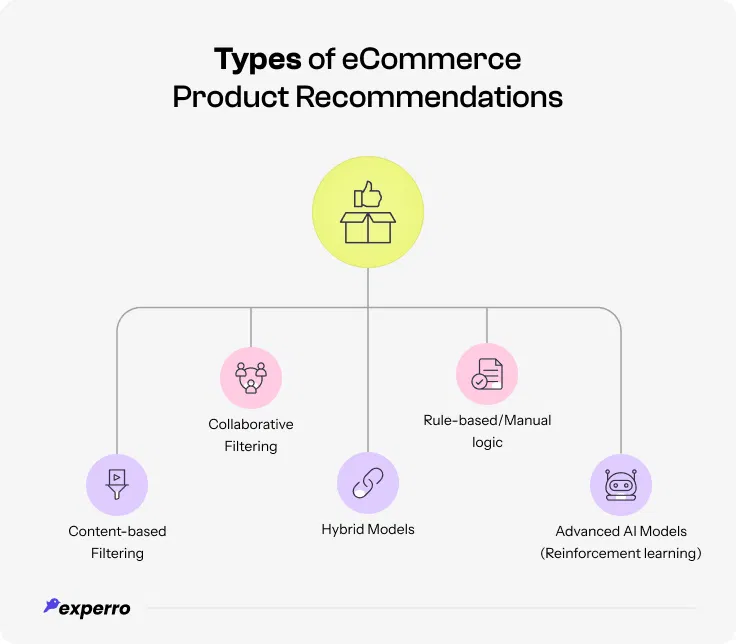
1. Content-based Filtering
This method recommends products similar to the ones a customer has interacted with. It focuses on product attributes like category, price, material, or size.
Such models are ideal when there's limited user data but rich product metadata. It's a common approach in recommender systems in eCommerce when you need highly relevant but narrow suggestions.
2. Collaborative Filtering
Here, the system suggests products based on what similar items that users have liked or purchased. If many users who bought running shoes also bought fitness bands, then fitness bands may be shown to another user buying shoes.
It requires a larger data set but delivers stronger personalized product recommendations.
3. Hybrid Models
Hybrid recommendation systems combine content-based and collaborative filtering approaches for more accurate web product recommendations.
Content-based recommendations form the foundation of advanced product suggestions and enhance customer satisfaction significantly. They both balance product similarity with user similarity, often reducing cold-start issues.
4. Rule-based / Manual Logic
Merchandisers manually define what products to recommend using business logic, like always pairing jeans with belts. Though less scalable, it ensures control and can align with campaigns or inventory goals.
This type works best in B2B eCommerce recommendations or when targeting specific high-margin items. Personalized merchandising is simple, but powerful for static bundles or curated experiences.
5. Advanced AI Models (Reinforcement Learning)
The future of product recommendation technology lies in models like reinforcement learning, where algorithms continuously learn from user interactions.
They’re ideal for brands investing in personalized recommendation engine capabilities with rich user data.
You can learn more about the main types of eCommerce product recommendations in our detailed blog.
Now, let’s look at strategies you can use to turn these recommendations into higher conversions.
Product Recommendation Strategies for Better Conversions
Knowing the types is great, but deploying them effectively requires a sound product recommendation strategy.
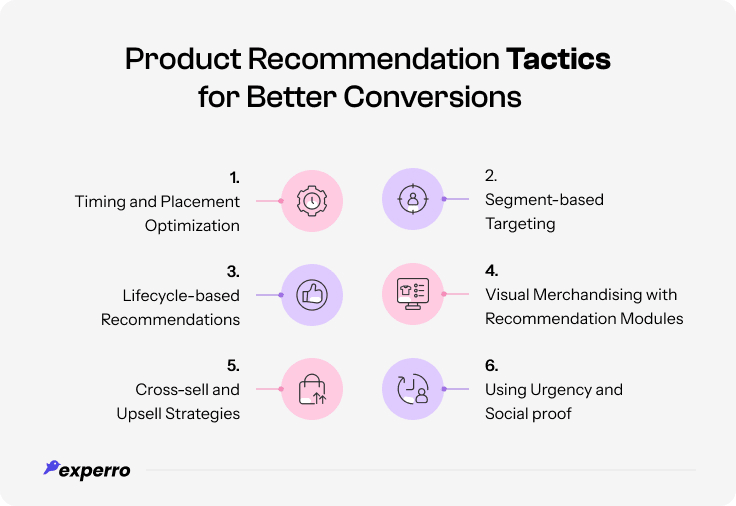
1. Timing and Placement Optimization
Where and when you show recommended products matters as much as what you show. Homepage, cart, emails, and exit-intent modals - all serve different goals.
Smart recommendations for eCommerce business adapt digital merchandising based on user journey stage, boosting interaction and conversions.
2. Lifecycle-based Recommendations
Tailor recommendations to where the user is in their buying journey, first-time visitor vs repeat customer.
For example, show bestsellers first, and suggest related or regularly-used items later.
3. Cross-sell and Upsell Strategies
Suggest complementary items to increase AOV. Think “Pair this necklace with matching earrings” or “Choose a larger diamond for more”.
These eCommerce recommendation tips can significantly boost revenue without additional ad spend.
4. Segment-based Targeting
Use segmentation to target customer groups like high spenders, and discount seekers to reduce cart abandonment.
Then deliver advanced product recommendations dynamically for each segment. This makes your recommendation for eCommerce website more strategic.
5. Visual Merchandising with Recommendation Modules
Design plays a role too. Attractive layouts, carousels, and smart titles like “You may also love” increase engagement.
Use searchandising and recommendation modules to nudge action.
6. Using Urgency and Social Proof
Labels like “Popular now” or “Trending” add urgency and boost trust. These AI product recommendations use real-time behavior and encourage impulse decisions.
It’s one of the most powerful product recommendations best practices.
Thus, these were the product recommendation strategies.
Optimize conversions using Experro’s AI recommendation engine!
How Product Recommendations Drive Profitability and Revenue?
When implemented strategically, eCommerce recommendations go beyond enhancing the customer journey, they directly fuel business growth.
From increasing cart sizes to reducing churn, the benefits of product suggestions are measurable and far-reaching (impacting many aspects of business performance over time).
Here’s how intelligent eCommerce product recommendations unlock new levels of profitability:
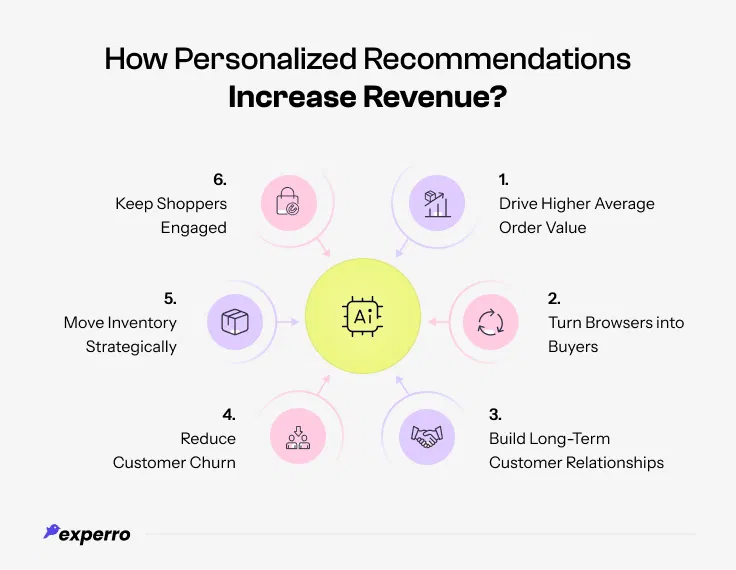
1. Drive Higher Average Order Value (AOV)
Cross-selling and upselling using recommendations for eCommerce increase how much an online shopper spends in a single session.
By suggesting complementary products or higher-tier products, you encourage customers to upgrade or add more to their cart.
For example, showing “Complete the Look” or “Buy it with...” modules can significantly raise transaction value. Optimizing recommendation for eCommerce website layouts ensures these offers are seen at the right moment, without disrupting the user flow.
2. Turn Browsers into Buyers
A well-timed product recommendation strategy helps convert casual site visitors into active purchasers. By displaying relevant recommendations tailored to browsing behavior, you remove the guesswork from a customer’s journey.
This is especially effective in large catalog management where search and recommendation tools assist discovery.
AI-driven logic also adapts suggestions in real-time, increasing the chances of conversion even during short sessions.
3. Build Long-Term Customer Relationships
Personalized touchpoints through customized recommendations for products show customers that you understand their needs.
This creates a sense of familiarity and trust which are the key drivers for retention and loyalty.
Over time, customers begin to rely on your online store as a trusted advisor, returning more frequently. Personalized product recommendations in eCommerce are a powerful foundation for relationship marketing.
4. Reduce Customer Churn
When a product is unavailable or doesn't meet user expectations, hyper-personalization in web product recommendations can save the sale.
By dynamically offering alternatives, you prevent frustration and keep users engaged. Churn reduction becomes easier with automated product recommendations that react instantly to inventory changes or behavior shifts.
This not only keeps customers coming back but also boosts how valuable your platform appears to them.
5. Move Inventory Strategically
Recommendations for eCommerce business can be used to shift overstocked, seasonal, or finishing inventory.
By configuring rules or using AI models, you can prioritize certain products in recommendation modules.
This avoids heavy markdowns and improves cash flow. Retailers benefit from balancing stock intelligently while still delivering relevant recommendations to the customer.
6. Keep Shoppers Engaged
The more time users spend exploring recommended products, the more opportunities you have to convert them.
Interactive carousels like “Recently Viewed Items” and “Others Also Liked” sections increase session duration and depth. Intelligent eCommerce product recommendations fuel continuous browsing and help you collect more behavior data.
This, in turn, sharpens future recommendation models and drives even better engagement loops.
After understanding how product recommendations boost profitability and revenue, let’s explore the key metrics that help measure their performance.
What Are the Key Metrics to Track Recommendation Performance?
To optimize your product recommendation algorithm, you need to measure the right KPIs. These metrics offer a clear picture of what's working and where improvements are needed.
With strong tracking, your eCommerce recommendations platform becomes a conversion powerhouse.
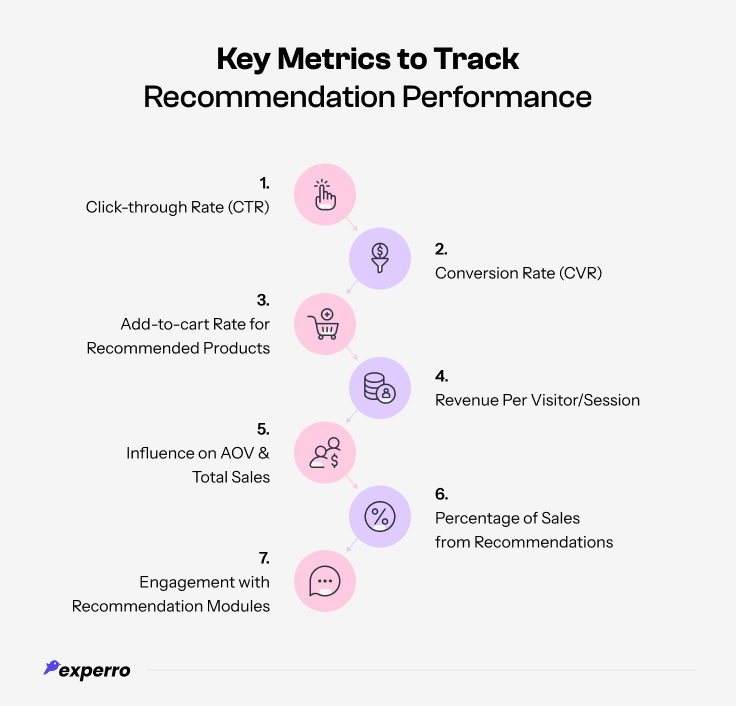
1. Click-through Rate (CTR)
CTR measures the percentage of users who clicked on a recommended product out of those who saw it. It indicates the initial appeal and search relevance of your eCommerce product recommendations.
A low CTR could signal poor placement, unengaging visuals, or irrelevant suggestions. Experimenting with messaging like “Popular now” or “Recommended for you” can boost visibility and interest.
2. Conversion Rate (CVR)
CVR evaluates how many users completed a purchase after clicking a product recommendation.
This shows the end-to-end effectiveness of your product recommendation strategy. A high CTR but low CVR might indicate a disconnect between the product and user intent.
Use Gen AI product recommendations to refine contextual targeting and improv conversion rate optimization.
3. Add-to-Cart Rate for Recommended Products
This tracks how often users add recommended products to their cart, helping you understand product desirability.
It’s especially useful for validating suggestions for eCommerce placement and pricing strategies.
Items frequently added but rarely purchased could signal pricing mismatches or delivery concerns. Optimizing these blocks boosts the value of each impression.
4. Revenue Per Visitor/Session
This metric reflects the total revenue generated per user session that engaged with recommendations for eCommerce.
It combines CTR, CVR, and AOV into a holistic performance view. A/B testing recommendation strategies can help you identify which models (e.g., collaborative, hybrid systems) deliver the highest ROI.
With the right product recommendations tools, you can tailor experiences across devices and channels to provide a seamless customer experience.
5. Influence on AOV and Total eCommerce Sales
Track how much your eCommerce recommendations are contributing to the increase in average cart value and total sales.
It quantifies the uplift driven by cross-sell and upsell strategies across sessions. This validates whether your product recommendation technology is translating into meaningful revenue.
Insights here can also guide discounting strategies and inventory planning.
6. Percentage of Sales from Recommendations
This measures the share of overall eCommerce site revenue directly attributed to recommended products. Top retailers report 20–35% of sales driven by AI eCommerce recommendations.
Tracking this helps justify continued investment and refine merchandising priorities. It also reveals which pages (PLPs, PDPs, cart) generate the highest value from an online recommendation engine blocks.
7. Engagement with Recommendation Blocks/Modules
Heatmaps, scroll-depth tracking, interaction, and other eCommerce analytics reveal how users are engaging with recommendation for eCommerce website placements.
High engagement often correlates with better layout, timing, and messaging. Low-performing blocks may benefit from repositioning, design updates, or switching to contextual recommendations.
Continuous testing ensures your product recommendations best practices evolve with user behavior.
See how AI Recommendations can boost your sales!
Experience Experro’s AI recommendations that personalize shopping and lift sales.
How Experro Helps You Deliver High-Converting Product Recommendations?
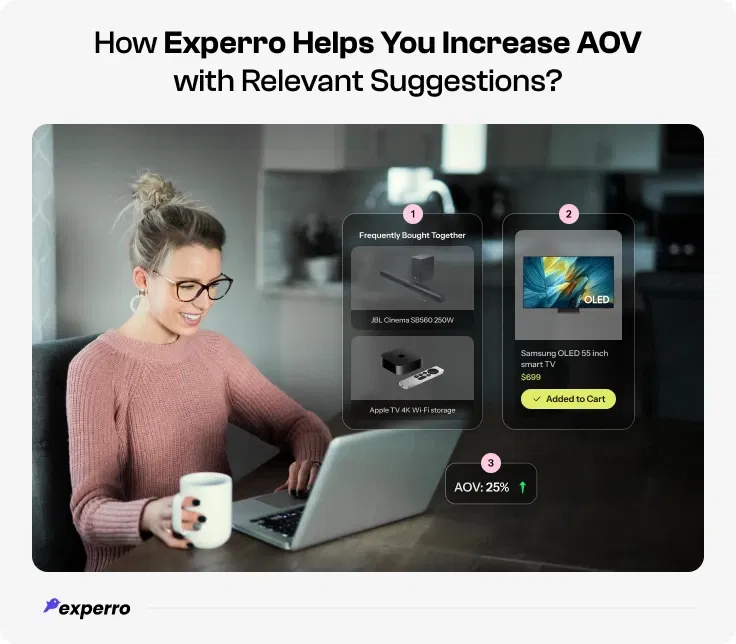
Experro helps you turn more customer interactions into sales opportunities with AI-powered recommendations that drive real results.
Whether you're looking to boost AOV or personalize shopper journeys, Experro delivers intelligent, real-time suggestions tailored to each user.
With features like typo tolerance, semantic search, and dynamic filters, its search engine enhances product discovery experiences and sets the foundation for smarter search and recommendation experiences.
You can fine-tune strategies, run A/B tests, and even deliver personalized product recommendations in B2B eCommerce environments.
With Experro, your recommendations for eCommerce business aren’t just reactive, they’re predictive, contextual, and built to drive measurable growth.
Conclusion
Product recommendations are the digital salesperson your eCommerce store can't afford to operate without.
By using the right models, eCommerce product recommendation tips, and platforms, brands can increase revenue and delight customers at every stage.
From contextual recommendations to advanced AI, the future is all about personalization. And with tools like Experro, achieving that future is well within reach.
If you're ready to boost conversions and sales, connect on a call with our experts for genuine guidance.
FAQs
What are personalized recommendations? What is the algorithm for ecommerce recommendations?
Personalized recommendations are product suggestions tailored to customer preferences, behavior, and past actions. These are essentially powered by AI or ML (machine learning) algorithms.
Which technology is most commonly used for personalized product recommendations?
Machine learning and collaborative filtering are the most widely used technologies in personalization recommendation engines.
Which brand uses personalized recommendations to engage its customers?
Diamonds Direct, one of the largest diamond jewelry retailers in the U.S., used Experro to create a fully personalized luxury shopping experience.
And, the results show:
- 10x faster mobile site speed
- Higher engagement and AOV than the previous year
- 42% revenue growth in the first year.
What is the difference between static and dynamic product recommendations?
Static product recommendations are rule-based and remain the same for every shopper, like showcasing bestsellers or new arrivals.
In contrast, dynamic recommendations adapt in real-time based on individual customer behavior, preferences, and trending data.
Dynamic models power personalized product recommendations in eCommerce, offering more relevant and timely suggestions that boost engagement and conversions.
How does Gen AI improve eCommerce recommendations?
Gen AI product recommendations enhance personalization by interpreting customer intent, context, and behavioral signals more accurately than traditional models.
They dynamically generate product suggestions tailored to each user in real time, leading to smarter, more responsive, and higher-converting shopping experiences. Gen AI helps elevate the performance of your search and recommendation engine at scale.
How do product recommendations impact conversion rates and revenue?
Effective eCommerce product recommendations help users discover relevant items faster, reducing bounce rates and increasing the likelihood of purchase.
These recommendations also encourage cross-sells and upsells, raising average order value (AOV). For many top-performing retailers, recommended products account for 20–30% or more of total sales, proving their direct impact on both conversion rates and revenue.
Can I test and A/B experiment with recommendation strategies in Experro?
Yes. Experro supports A/B testing for recommendation blocks, helping you optimize product recommendation strategies for maximum ROI.
Pallavi Dadhich
Content Writer @ ExperroPallavi is an ambitious author recognized for her expertise in crafting compelling content across various domains. Beyond her professional pursuits, Pallavi is deeply passionate about continuous learning, often immersing herself in the latest industry trends. When not weaving words, she dedicates her time to mastering graphic design.
What's Inside
- What Are Product Recommendations in eCommerce?
- How Does a Product Recommendation Engine Work?
- Personalized vs Non-Personalized Recommendations
- What Are the Types of eCommerce Product Recommendations?
- Product Recommendation Strategies for Better Conversions
- How Product Recommendations Drive Profitability and Revenue?
- What Are the Key Metrics to Track Recommendation Performance?
- How Experro Helps You Deliver High-Converting Product Recommendations?
- Conclusion
Subscribe to Our Newsletters
Get the latest insights delivered straight to your inbox.